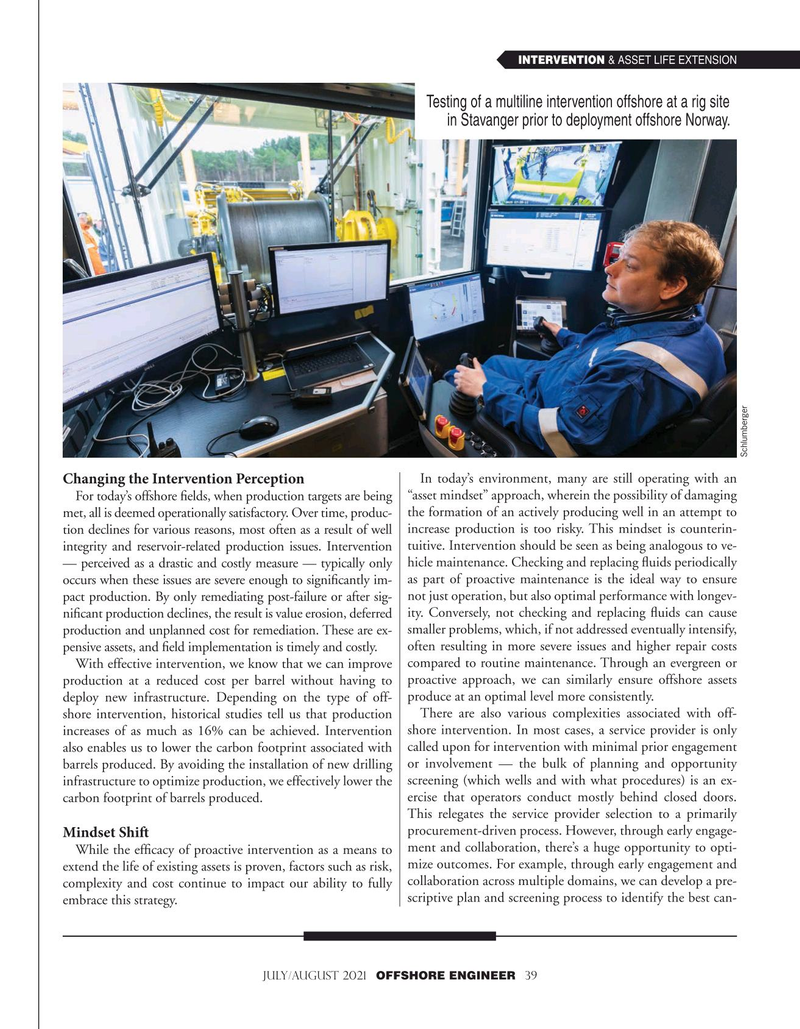
Page 39: of Offshore Engineer Magazine (Jul/Aug 2021)
The Robotics Revolution
Read this page in Pdf, Flash or Html5 edition of Jul/Aug 2021 Offshore Engineer Magazine
INTERVENTION & ASSET LIFE EXTENSION
Testing of a multiline intervention offshore at a rig site in Stavanger prior to deployment offshore Norway.
Schlumberger
In today’s environment, many are still operating with an
Changing the Intervention Perception
For today’s offshore felds, when production targets are being “asset mindset” approach, wherein the possibility of damaging met, all is deemed operationally satisfactory. Over time, produc- the formation of an actively producing well in an attempt to tion declines for various reasons, most often as a result of well increase production is too risky. This mindset is counterin- integrity and reservoir-related production issues. Intervention tuitive. Intervention should be seen as being analogous to ve- — perceived as a drastic and costly measure — typically only hicle maintenance. Checking and replacing fuids periodically occurs when these issues are severe enough to signifcantly im- as part of proactive maintenance is the ideal way to ensure pact production. By only remediating post-failure or after sig- not just operation, but also optimal performance with longev- nifcant production declines, the result is value erosion, deferred ity. Conversely, not checking and replacing fuids can cause production and unplanned cost for remediation. These are ex- smaller problems, which, if not addressed eventually intensify, pensive assets, and feld implementation is timely and costly. often resulting in more severe issues and higher repair costs
With effective intervention, we know that we can improve compared to routine maintenance. Through an evergreen or production at a reduced cost per barrel without having to proactive approach, we can similarly ensure offshore assets deploy new infrastructure. Depending on the type of off- produce at an optimal level more consistently.
shore intervention, historical studies tell us that production There are also various complexities associated with off- increases of as much as 16% can be achieved. Intervention shore intervention. In most cases, a service provider is only also enables us to lower the carbon footprint associated with called upon for intervention with minimal prior engagement barrels produced. By avoiding the installation of new drilling or involvement — the bulk of planning and opportunity infrastructure to optimize production, we effectively lower the screening (which wells and with what procedures) is an ex- carbon footprint of barrels produced. ercise that operators conduct mostly behind closed doors.
This relegates the service provider selection to a primarily procurement-driven process. However, through early engage-
Mindset Shif
While the effcacy of proactive intervention as a means to ment and collaboration, there’s a huge opportunity to opti- extend the life of existing assets is proven, factors such as risk, mize outcomes. For example, through early engagement and complexity and cost continue to impact our ability to fully collaboration across multiple domains, we can develop a pre- scriptive plan and screening process to identify the best can- embrace this strategy.
JULY/AUGUST 2021 OFFSHORE ENGINEER 39

 38
38

 40
40